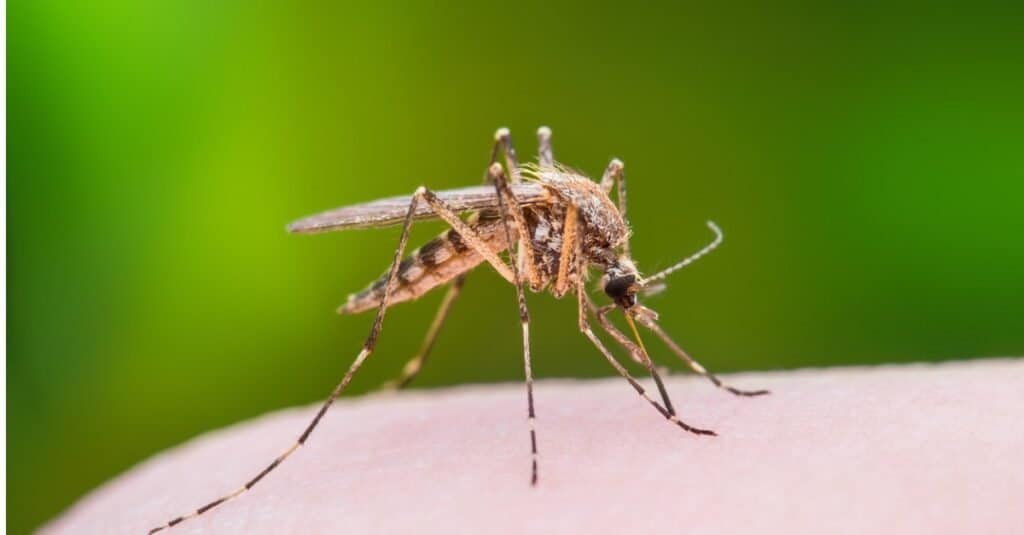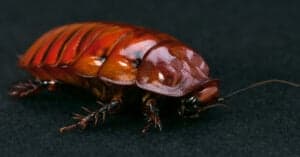Crane flies and mosquitoes are frequently confused for the other – not helped by the fact that crane flies are sometimes called “mosquito hawks”. Not to mention that they look quite similar at first glance and both are found in similar habitats. However, the truth is they are actually two completely different species.
So, just what sets these two insects apart? Well, one is much bigger than the other, and has much longer legs, and one has two pairs of wings rather than one. But perhaps the most important difference is that one is completely harmless, while the other can pass on deadly diseases. Join us as we discover all of the differences between crane fly vs mosquito.
Comparing Mosquito vs Crane Fly
Crane flies and mosquitoes are both flying insects that have long legs. They’re also both often found in the same habitat – in warm and wet locations – and lay their eggs near water. However, despite these similarities, they are actually very different when we look at them more closely and there are a few key differences that make it really easy to tell which is which.
Check out the chart below to learn a few of the main differences between crane fly vs. mosquito.
| Mosquito | Crane Fly | |
| Size & Shape | Between 0.15 and 0.4 inches long. Have a bent thorax and abdomen. Have a needle-like mouth for sucking blood | Around 1.5 inches long. Straight bodies. Females have ovivpositor on their abdomen for laying eggs |
| Legs | Long and thin | Around twice the length of their bodies (much longer than mosquitoes) |
| Wings | Two pairs – one for flying, second pair is much smaller. Wingspan around 0.94 inches | One pair. Wingspan usually between 0.5 and 2.5 inches |
| Antenna | Hairy | Not hairy |
| Diet | Both males and females feed on nectar and other plant juices, but females also feed on human and animal blood | Do not eat at all in the adult stage. Larvae feed on flowers, grass roots, algae etc |
| Threat | Females feed on blood and can pass on harmful diseases such as malaria | Completely harmless to humans – don’t bite or sting |
| Time most active | Crepuscular – most active at dawn and dusk | Nocturnal but attracted to lights |
| Lifespan | Males 6 to 7 days, females average 6 weeks, but up to 5 months is possible | 10 to 15 days |
The 6 Key Differences Between Crane Fly vs Mosquito

Mosquitoes have a bent thorax and abdomen which gives them a hunched appearance
©iStock.com/nechaev-kon
Crane Fly vs Mosquito: Size & Shape
One of the most noticeable differences between crane flies and mosquitoes is the difference in their sizes. Crane flies are much larger than mosquitoes. They have long, straight bodies which are around 1.5 inches long. Females also have an ovivpositor at the bottom of their abdomens which are used for laying eggs on the ground with. Mosquitoes are only between 0.15 and 0.4 inches long and have a bent thorax and abdomen which gives them a hunched appearance. They also have a needle-like mouth which is known as a proboscis and is used for sucking up blood with.
Crane Fly vs Mosquito: Legs
Although mosquitoes have fairly long legs themselves, they still don’t come anywhere near the incredible length of those of a crane fly. Crane flies have legs that are around twice the length of their bodies. Therefore, it’s not surprising that they are also sometimes known as “daddy longlegs”.
Crane Fly vs Mosquito: Wings
Another major difference is their wings. Crane flies have one pair of wings and their wingspan is usually between 0.5 and 2.5 inches, although occasionally some can reach 4.5 inches. Mosquitoes have two pairs of wings – one for flying and another much smaller pair. The smaller pair are known as “halteres”. Their entire wingspan is only around 0.94 inches.
Crane Fly vs Mosquito: Diet
Adult crane flies don’t eat at all, but larvae feed on plants, crops, seedlings, grass roots, and algae. Both male and female mosquitoes feed on nectar and other plant juices. However, the big difference is that female mosquitoes feed on both human and animal blood.
Crane Fly vs Mosquito: Threat
One of the biggest differences between crane flies and mosquitoes is how dangerous they are. As we’ve already mentioned, female mosquitoes feed on blood, and this allows them to transmit harmful diseases such as malaria. By contrast, crane flies are completely harmless. On the other hand, crane flies very rarely eat during their adult stage and they don’t bite or sting.

Long legs – crane flies have legs that are twice the length of their bodies
©iStock.com/maselkoo99
Crane Fly vs Mosquito: Time Most Active
Crane flies are nocturnal so are most active during the night but are attracted to lights. This is why if they are in a house they can usually be seen bobbing around by the light bulb. Mosquitoes are crepuscular which means that they are most active during the twilight hours – dawn and dusk. Mosquitoes tend to avoid direct sunlight as it can quickly dehydrate and kill them. Therefore, during the day they are often found in shaded wetland areas.
FAQ’s (Frequently Asked Questions)
Are crane flies and mosquitoes from the same family group?
No, crane flies are from the family group Tipulidae while mosquitoes are from the family Culicidae.
Why are crane flies sometimes called “mosquito hawks”?
Crane flies are sometimes called “mosquito hawks” because many people originally thought that they preyed on mosquitoes. However, this is not true because crane flies don’t eat or harm any insects at all.
Do mosquitoes and crane flies live in the same habitat?
Yes, mosquitoes and crane flies share a similar habitat and both like to live in warm, moist areas near to water. However, mosquitoes are found on every continent except Antarctica, while crane flies can survive – and even thrive – in cold regions such as Antarctica, Alaska, and the Arctic Circle.
How many species of crane flies and mosquitoes are there?
There are around 5,000 species of crane flies and around 3,000 species of mosquitoes in the world.
Are all mosquitoes dangerous?
No, as we’ve already mentioned, it’s only female mosquitoes that suck blood and therefore pass on diseases. However, despite there being thousands of species of mosquitoes, only around 200 of them are known to actually bite humans.
Are mosquitoes and crane flies good fliers?
Mosquitoes are quick and agile fliers and are able to move and change direction quickly. However, crane flies are known for their “wobbly” appearance when flying. This is because their long bodies and long legs make flying quite difficult for them, and as a result they are quite slow and weak when flying.
The photo featured at the top of this post is ©
Thank you for reading! Have some feedback for us? Contact the AZ Animals editorial team.






